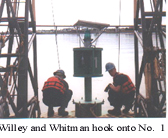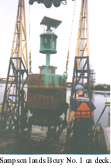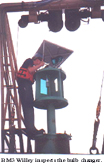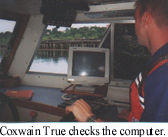It's all in a Day's Work for South Portland based Coast
Guard Buoy Tenders
Floating Signposts for Supertankers Need Constant Care.
by
Jack Reynolds
As the final snappy bugle notes of morning colors fade, Coxwain Tyler
True revs up Buoy Tender 46302 and eases away
from the South Portland Coast Guard Base. Another day in the battle
to keep the station's 372 aids floating and flashing at their assigned
station gets underway.
True,
a boatswainsmate second class (BM2), cons the 46-foot black barge
shaped vessel under the Casco Bay Bridge and closes in on Fore River
Channel Green Lighted Buoy No. 1. This time it's just a routine annual
maintenance check. The Coast Guard's annual check policy keeps most
of its aids on station and functioning between inspections. Its the
unforeseen, however, that keeps True and fellow buoy tender
skippers hopping. Fixing and replacing buoys moved or damaged by
ice, ship collisions, and tides is all in a day's work. Sometimes
its just a matter of a good legal defense.
 "If
a merchant vessel runs aground we have to check on the aid's position to
make sure the grounding was not our fault." said True. "And buoys
do move around. Even a moon tide can stretch out the chain and lift the
sinker from the bottom. In other cases, the problem is with the light.
A big fishing boat colliding with a lighted buoy can destroy the lighting
mechanism."
"If
a merchant vessel runs aground we have to check on the aid's position to
make sure the grounding was not our fault." said True. "And buoys
do move around. Even a moon tide can stretch out the chain and lift the
sinker from the bottom. In other cases, the problem is with the light.
A big fishing boat colliding with a lighted buoy can destroy the lighting
mechanism."
True, his crew of three, and their small black hulled vessel serve
in the Coast Guard's workaday "black boat navy" Buoy Tender
46302's only resemblance to spit and polish "white boat navy" cutters
is its colorful Coast Guard diagonal bow stripe.
But it means business. For close-in work its Schottel swiveling propellor
can turn it on a dime and the yellow two legged hoist towering over
its stern can snatch a 4000 pound concrete buoy anchor from deep
water. It can make two week cruises to service navigation aids in
any of the Gulf of Maine harbors and rivers.
 A
few yards from morning commuters whizzing along Commercial Street,
True positions the tender's stern over Buoy No. 1. Crew members,
BM3 Jason Willey from Vermont and BM2 Mike Whitman from Pennsylvania,
hook the hoist wires onto its hull mounted hoisting pad eyes.
Fireman Matt Sampson, a Florida native, finesses the hydraulic hoist
controls to guide the buoy's delicate solar panel under the hoist cross
bar. The 5-foot diameter steel hull eases to a soft landing
on deck. Willey and Whitman with help from Sampson's winch next grapple
No. 1's 30 feet of anchor chain to short stay. Micrometer
readings of links tell the condition of the chain links; those that
scrape on the bottom get close attention.
A
few yards from morning commuters whizzing along Commercial Street,
True positions the tender's stern over Buoy No. 1. Crew members,
BM3 Jason Willey from Vermont and BM2 Mike Whitman from Pennsylvania,
hook the hoist wires onto its hull mounted hoisting pad eyes.
Fireman Matt Sampson, a Florida native, finesses the hydraulic hoist
controls to guide the buoy's delicate solar panel under the hoist cross
bar. The 5-foot diameter steel hull eases to a soft landing
on deck. Willey and Whitman with help from Sampson's winch next grapple
No. 1's 30 feet of anchor chain to short stay. Micrometer
readings of links tell the condition of the chain links; those that
scrape on the bottom get close attention.
After scraping green layers of marine growth from the hull, Willey flips
open the green light to check on its 6 bulbs. The bulbs are mounted
in circular tray that rotates a fresh bulb into firing position when its
predecessor has burned out.

Depending on conditions each of the low wattage bulbs is good for about
six months. The Fresnell shaped lens magnifies the bulb's feeble
1.15 watts to a bright green flash visible for several miles. "A bulb can
last up to six months," says Willey, " but the vibration on bell buoys
cuts that down."
Willey next tests the battery voltage and solar panel voltages.
He finishes up with an inspection of the flasher mechanism. At night mariners
recognize No. 1. by its "characteristic" green flash every 2.5 seconds.
They depend on it to guide their tankers safely up river to the oil docks.
The size of those passing tankers and the hazardous cargoes they are hauling
has earned No. 1 an "Alpha" rating. Its 50-foot
diameter swinging circle is the lowest tolerance allowed by the Coast Guard.
Less critical buoys descend the Coast Guard's phonetic alphabet scale
to the lowest rating of "Foxtrot."
With its hull scraped, and mooring chain and electrical system checked
out, Fore River Channel No. 1 Green Lighted Buoy is ready for resetting. True scrolls through the wheelhouse computer's
menus of rivers and bays from Southwest Harbor to New Hampshire under the
care of South Portland Station. "Local," the designation for Portland Harbor
lights up. One more tap on the computer keyboard fills the screen
with No. 1's specifications. A GPS position fix beamed from an orbiting
satellite to pilot house computer shows that at the stern of the True's
vessel in over the designated position. Sampson eases
the 11-foot high green structure back into the water.
ready for resetting. True scrolls through the wheelhouse computer's
menus of rivers and bays from Southwest Harbor to New Hampshire under the
care of South Portland Station. "Local," the designation for Portland Harbor
lights up. One more tap on the computer keyboard fills the screen
with No. 1's specifications. A GPS position fix beamed from an orbiting
satellite to pilot house computer shows that at the stern of the True's
vessel in over the designated position. Sampson eases
the 11-foot high green structure back into the water.
True
scrolls down through the Local menu to the next project on today's schedule
and guns the boat toward a red nun a quarter mile further up-river.
Meanwhile, Fore River Channel No. 1 should be good for another year.
BM2 True and his crew have something in common with painters of big
bridges. Just when you get to the end its time to start again.
Back to Page One
.
 "If
a merchant vessel runs aground we have to check on the aid's position to
make sure the grounding was not our fault." said True. "And buoys
do move around. Even a moon tide can stretch out the chain and lift the
sinker from the bottom. In other cases, the problem is with the light.
A big fishing boat colliding with a lighted buoy can destroy the lighting
mechanism."
"If
a merchant vessel runs aground we have to check on the aid's position to
make sure the grounding was not our fault." said True. "And buoys
do move around. Even a moon tide can stretch out the chain and lift the
sinker from the bottom. In other cases, the problem is with the light.
A big fishing boat colliding with a lighted buoy can destroy the lighting
mechanism."
 A
few yards from morning commuters whizzing along Commercial Street,
True positions the tender's stern over Buoy No. 1. Crew members,
BM3 Jason Willey from Vermont and BM2 Mike Whitman from Pennsylvania,
hook the hoist wires onto its hull mounted hoisting pad eyes.
Fireman Matt Sampson, a Florida native, finesses the hydraulic hoist
controls to guide the buoy's delicate solar panel under the hoist cross
bar. The 5-foot diameter steel hull eases to a soft landing
on deck. Willey and Whitman with help from Sampson's winch next grapple
No. 1's 30 feet of anchor chain to short stay. Micrometer
readings of links tell the condition of the chain links; those that
scrape on the bottom get close attention.
A
few yards from morning commuters whizzing along Commercial Street,
True positions the tender's stern over Buoy No. 1. Crew members,
BM3 Jason Willey from Vermont and BM2 Mike Whitman from Pennsylvania,
hook the hoist wires onto its hull mounted hoisting pad eyes.
Fireman Matt Sampson, a Florida native, finesses the hydraulic hoist
controls to guide the buoy's delicate solar panel under the hoist cross
bar. The 5-foot diameter steel hull eases to a soft landing
on deck. Willey and Whitman with help from Sampson's winch next grapple
No. 1's 30 feet of anchor chain to short stay. Micrometer
readings of links tell the condition of the chain links; those that
scrape on the bottom get close attention.

 ready for resetting. True scrolls through the wheelhouse computer's
menus of rivers and bays from Southwest Harbor to New Hampshire under the
care of South Portland Station. "Local," the designation for Portland Harbor
lights up. One more tap on the computer keyboard fills the screen
with No. 1's specifications. A GPS position fix beamed from an orbiting
satellite to pilot house computer shows that at the stern of the True's
vessel in over the designated position. Sampson eases
the 11-foot high green structure back into the water.
ready for resetting. True scrolls through the wheelhouse computer's
menus of rivers and bays from Southwest Harbor to New Hampshire under the
care of South Portland Station. "Local," the designation for Portland Harbor
lights up. One more tap on the computer keyboard fills the screen
with No. 1's specifications. A GPS position fix beamed from an orbiting
satellite to pilot house computer shows that at the stern of the True's
vessel in over the designated position. Sampson eases
the 11-foot high green structure back into the water.